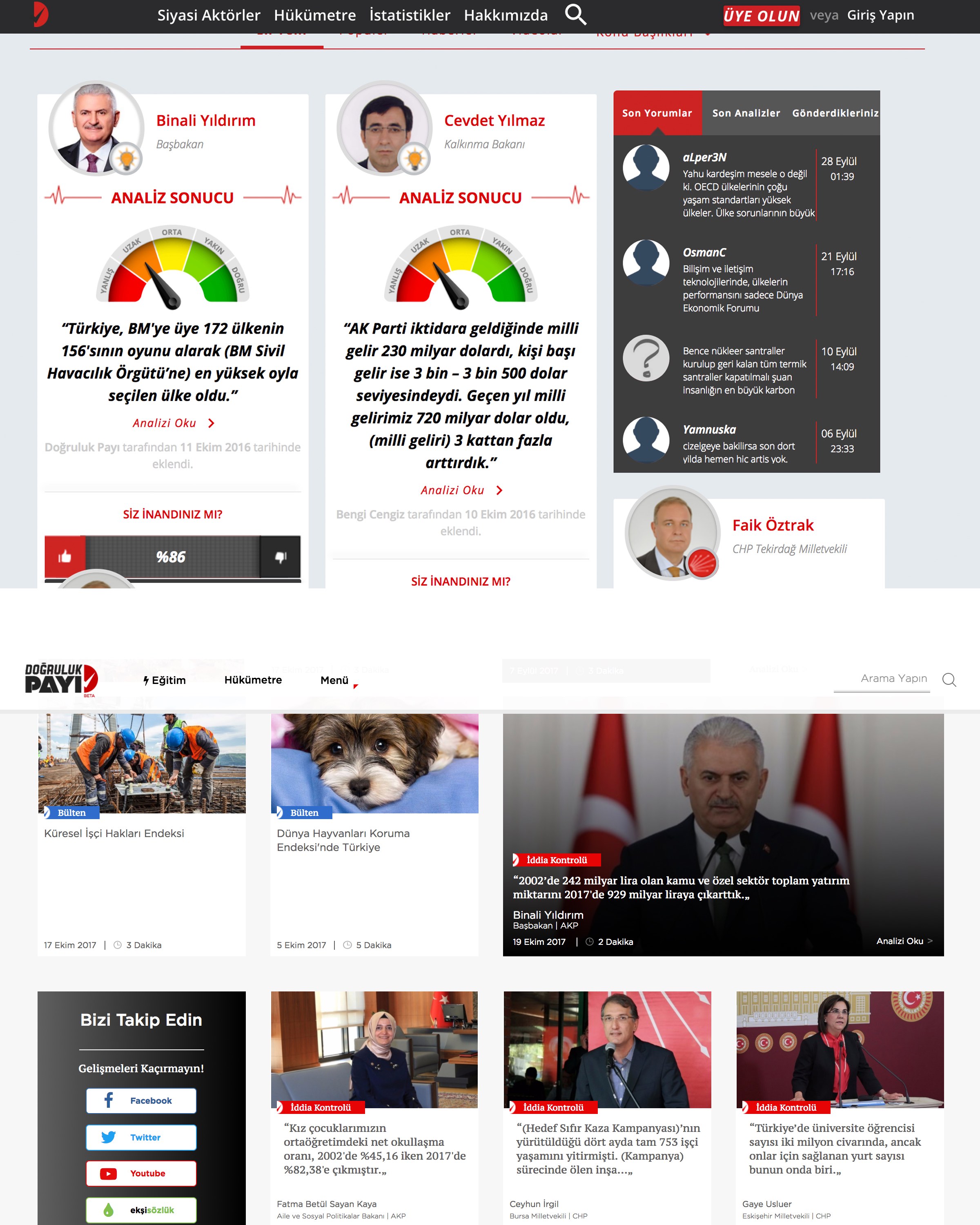Editor's note: This article has been updated with FactCheck.org and PolitiFact's latest traffic numbers.
Less is more. At least, that’s Doğruluk Payi’s new homepage strategy.
The Turkish fact-checking organization announced a major redesign to its website this week in which it relegated its claim ratings to the story level, removing them from the homepage. Baybars Örsek, founding executive editor of Doğruluk Payi, told Poynter the redesign was aimed at increasing the amount of time readers spend on each of their fact checks.
The move comes after weeks of beta testing with 25 different users, Örsek said. What they found was that respondents were barely reading their stories at all — they were skimming the ratings on the homepage.
“We found that most of the visitors, especially the first-time visitors, do not go into the details of the fact check,” he said. “There was no incentive for our visitors to dig deeper into the fact check that we had worked on.”
Since rolling out the new website design about two weeks ago, Doğruluk Payi, which was launched in 2014, has already seen the number of articles readers click on double — a measurement Örsek said is bolstered by the addition of infinite scroll on the site. In the previous layout, the average reader only spent time on two to four different fact checks per session, he said.
“They are more obliged to go into the deep (parts) of our website,” he said. “In the previous layout, it was just the homepage that was most interesting.”

Every fact-checking outlet wants readers to spend more time on their site. But should every organization forgo putting statement ratings front-and-center?
Angie Holan, editor of PolitiFact (a project of the Poynter-owned Tampa Bay Times) doesn’t think so. She told Poynter that putting ratings on their homepage is central to the organization’s reader appeal.
“Politifact was designed with the ratings on the homepage as a reader service,” she said. “It’s like giving our readers the experience they want when they come to our website. Some of them want to read the whole check and some of them want to read the whole rating.”
Like most things in journalism, some of it comes down to traffic. Holding off on a redesign is easier when a fact-checking site has hundreds of thousands — or even millions — of pageviews, Holan said. While PolitiFact has received about 6 million pageviews over the past 30 days, according to Executive Director Aaron Sharockman, Örsek said Doğruluk Payi gets about 10,000 per day.
At the same time, more traffic is alluring. Holan said PolitiFact has briefly toyed with the idea of limiting its claim ratings to the story level, and has even tried altering its newsletters to see how readers react to the change.
It didn’t go well.
“Readers hated it. They thought it was annoying,” she said. “We would have to balance the number of increased page views with the number of unhappy readers who didn’t like it.”
At FactCheck.org, which doesn’t use ratings like PolitiFact and Doğruluk Payi, the homepage is organized like a traditional news outlet. Eugene Kiely, editor of the nonprofit fact-checking outlet, told Poynter that their main focus is presenting fact checks in an objective, clean way.
“Our goal is to give readers a summary in the headline, and hopefully it’s enticing enough to click through,” he said. “Our conclusions are right there … you’re going to want to click on to find out exactly what we meant.”
And that philosophy seems to be working. Kiely said readers spend an average of two minutes on a page while visiting FactCheck.org, which he said had received about 1.5 million unique pageviews for the 30-day period ending Sept. 17. He also said that number has decreased substantially since the 2016 U.S. presidential election, but visitors are staying much longer.
To Kiely, a key part of drawing in more readers comes down to a long-held contentious debate in the fact-checking community: Should fact-checkers use ratings to promote their work?
“Doing ratings is a subjective exercise,” Kiely said. “I don’t want to tarnish the objective reporting and research that went into a piece by opening ourselves up to an argument over how it was ultimately rated.”
While organizations like FactCheck.org and others around the world don’t use claim ratings, fact-checkers at places like PolitiFact and The Washington Post have made their rating scales an essential part of their brands. While the former camp argues that rating things with Pinocchios or Pants on Fire ratings could turn off some people who perceive them as biased, the latter sees them as a quick, user-friendly way to deliver the truth to readers.
Divisions notwithstanding, Holan said the kinds of people who read fact-checking sites regularly enough to visit the homepage are probably interested in reading an entire fact check anyway. And she’s not too preoccupied with worrying over whether people are just skimming the homepage or not.
“Isn’t that like going to The New York Times and reading the headlines and getting your news that way?” she said. “I’m going to pick the ones that seems the most interesting to me. I suspect that people interact with PolitiFact the same way.”
Ultimately, it all comes down to your readers. And Doğruluk Payi’s have been mostly supportive of the site redesign.
“We always had this motivation to make a better user experience in our website,” Örsek said. “We didn’t want to seem like we were doing clickbait. Our main aim is to inform the public.”







